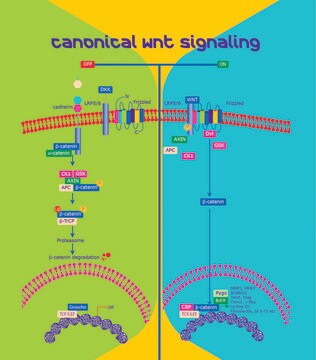推荐产品
化驗
≥92% (HPLC)
形狀
lyophilized
成份
Peptide Content, ≥75%
儲存條件
protect from light
儲存溫度
−20°C
Amino Acid Sequence
Glp-Gly-Pro-Trp-Leu-Glu-Glu-Glu-Glu-Glu-Ala-Tyr-Gly-Trp
一般說明
Gastrin, a classic digestive hormone, is found in three major forms: gastrin-34 (big gastrin), gastrin-17 (little gastrin), and gastrin-13 (minigastrin). Mammalian gastrin consists of a C-terminal four amino-acid sequence and a sulfated tyrosine 7 residue from the C-terminus. Gastrin is mostly found in the G cells of the stomach mucosa. Nutrients and gastrin-releasing peptides stimulate the release of gastrin.
應用
Gastrin I (1-14) has been used:
- as a component of gastric cancer stem/progenitor cell (GCSPC) medium for tumorsphere culture
- as a supplement in organoid growth medium (OGM) for patient-derived organoid (PDO)
- in viable lymphocytes culture for re-stimulation assay
生化/生理作用
Gastrin is a linear polypeptide that induces the secretion of gastric acid (HCl) by parietal cells.
The peptide gastrin I (1-14), which lacks a basic site, forms positive ions. Gastrin promotes the production and liberation of histamine in enterochromaffin-like cells through cholecystokinin 2 receptor (CCK2R). It also stimulates the release of gastric acid in parietal cells via the CCK2R receptor. Gastrin plays a key role in Zollinger-Ellison syndrome. It may play a role in the development of colorectal carcinoma.
儲存類別代碼
11 - Combustible Solids
水污染物質分類(WGK)
WGK 3
閃點(°F)
Not applicable
閃點(°C)
Not applicable
其他客户在看
C M Thorburn et al.
Gastroenterology, 115(2), 275-280 (1998-07-25)
Gastrin is a putative promoter of colorectal carcinomas. The aim of this study was to evaluate the temporal relationship between gastrinemia and development of colorectal malignancy. We conducted a nested case-control study among 128,992 subscribers to a health maintenance program
Zhi-Feng Miao et al.
Stem cells (Dayton, Ohio), 32(12), 3062-3074 (2014-08-22)
Peritoneal dissemination is the most common cause of death in gastric cancer patients. The hypoxic microenvironment plays a major role in controlling the tumor stem cell phenotype and is associated with patients' prognosis through hypoxia-inducible factor-1α (HIF-1α), a key transcriptional
Nicholas Osborne et al.
Cancer immunology, immunotherapy : CII, 68(10), 1635-1648 (2019-09-25)
Pancreatic cancer has been termed a 'recalcitrant cancer' due to its relative resistance to chemotherapy and immunotherapy. This resistance is thought to be due in part to the dense fibrotic tumor microenvironment and lack of tumor infiltrating CD8 + T cells. The
Junjie Gao et al.
Rapid communications in mass spectrometry : RCM, 22(24), 4066-4072 (2008-11-21)
Negative ion production from peptides and proteins was investigated by matrix-assisted laser desorption/ionization time-of-flight (MALDI-TOF) mass spectrometry. Although most research on peptide and protein identification with ionization by MALDI has involved the detection of positive ions, for some acidic peptides
F L Lai Benjamin et al.
Advanced functional materials, 30(48) (2021-03-12)
Tumor progression relies heavily on the interaction between the neoplastic epithelial cells and their surrounding stromal partners. This cell cross-talk affects stromal development, and ultimately the heterogeneity impacts drug efflux and efficacy. To mimic this evolving paradigm, we have micro-engineered
我们的科学家团队拥有各种研究领域经验,包括生命科学、材料科学、化学合成、色谱、分析及许多其他领域.
联系技术服务部门
![[亮氨酸15]-胃泌素 I 人类 ≥95% (HPLC)](/deepweb/assets/sigmaaldrich/product/structures/153/342/d4cb3dd7-13f1-46cf-8d1f-3907a5de7a83/640/d4cb3dd7-13f1-46cf-8d1f-3907a5de7a83.png)












